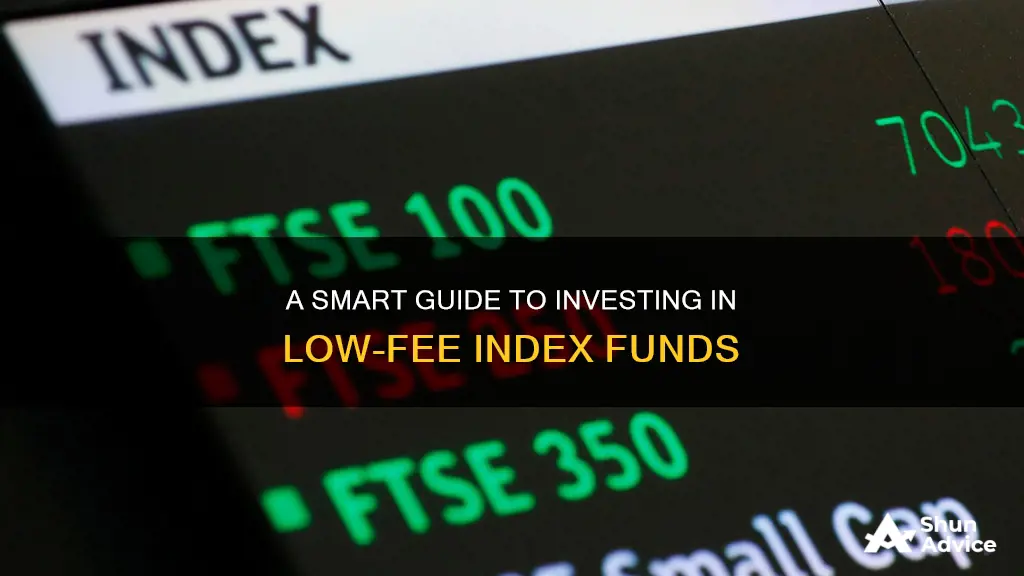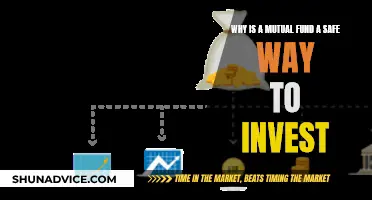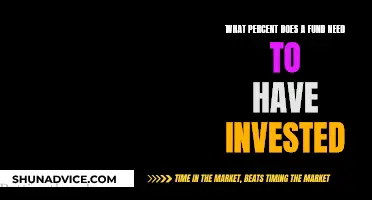
Index funds are a great way to invest in the stock market and minimise fees. They are a type of exchange-traded fund (ETF) or mutual fund that tracks a specific collection of assets called an index. The index can include stocks, bonds and other assets, and the fund does not actively invest in the market but tries to match the performance of the index by holding the same assets in the same proportions.
Index funds are popular with investors because they promise ownership of a wide variety of stocks, greater diversification, lower risk and attractive returns, all at a low cost. They are also good for beginners as you don't need to know much about investing or financial markets to do well.
When choosing an index fund, it's important to consider the fund's expenses, taxes, and investment minimums. It's also crucial to research and analyse the index fund to understand what you're investing in, including the geographic location, business sector and market opportunity.
Some of the best low-cost index funds include the Vanguard Total Stock Market Index Fund ETF, the Vanguard S&P 500 ETF, the Vanguard Mid-Cap ETF and the Vanguard Small-Cap ETF.
| Characteristics | Values |
|---|---|
| Type of investment fund | Mutual fund or exchange-traded fund (ETF) |
| Investment strategy | Passive investing |
| Investment objective | Track a specific collection of assets (index) without active management |
| Diversification | Ownership of a wide variety of stocks |
| Risk | Lower than investing in individual stocks |
| Returns | Attractive returns, e.g. S&P 500's long-term record of about 10% annually |
| Fees | Low expense ratios and no sales load |
| Taxes | ETFs are more tax-efficient than mutual funds |
| Investment minimums | ETFs typically have lower or no minimum investment requirements |
What You'll Learn

Understand the different types of index funds
Index funds are a great way to invest in the stock market, reduce risks, and minimize the time and money spent investing. They are also a great choice if you want to diversify your portfolio. Here is a detailed overview of the different types of index funds:
Broad Market Index Funds
Broad market index funds aim to capture most of the investable market, including stocks, bonds, or other assets. While some funds focus on large-cap or small-cap stocks, broad market index funds cover both areas. These funds are a great option if you want low-cost exposure to an entire asset class or a specific country or region. Examples include the Vanguard Total Stock Market ETF (VTI) and the Vanguard Total Bond Market ETF (BND).
Market Cap Index Funds
Market cap index funds invest based on specific market capitalization ranges. A company's market cap is the total value of its outstanding shares, and companies can be categorized as large-cap, small-cap, or mid-cap based on these values. Large-cap funds, like those tracking the S&P 500, hold companies with market caps above $10 billion, while small-cap funds focus on companies with market caps below $2 billion. The Fidelity 500 Index Fund (FXAIX) and the Vanguard Mid-Cap ETF (VO) are examples of market cap index funds.
Equal Weight Index Funds
Most stock index funds are weighted by market cap, meaning that companies with higher values make up larger percentages of the fund's portfolio. Equal weight index funds, on the other hand, give each holding in the fund an equal percentage of fund assets. For example, if a fund has 100 holdings, each one will account for about 1% of the portfolio. The Invesco S&P 500 Equal Weight ETF (RSP) and the Direxion Nasdaq-100 Equal Weighted Index Shares (QQQE) are popular equal weight funds.
Fixed Income/Debt Index Funds
Fixed income or debt index funds allow investors to invest in bonds. These funds track bond indices in the same way that stock funds track stock market indices, allowing them to charge low expense ratios compared to actively managed funds. Bonds can be an important part of your portfolio, especially during retirement. Examples of fixed income/debt index funds include the Vanguard Long-Term Bond ETF (BLV) and the Fidelity Municipal Bond Index Fund (FMBIX).
Sector-Based Index Funds
Sector-based index funds are ideal if you have a specific view on a certain area of the economy. These funds allow you to express an investment opinion without the need to research individual securities. You might invest in a fund focused on the technology sector or financials if you expect rising interest rates. Examples include the Consumer Discretionary Select Sector SPDR Fund (XLY) and the Fidelity MSCI Financials Index ETF (FNCL).
International Index Funds
International index funds provide an easy way to gain exposure to geographic areas outside of your home country. With a single fund, you can invest in a diversified portfolio of companies from a specific country or region. This is a simple way to invest in economies outside of your domestic market, such as Europe or the Asia-Pacific region. Examples include the Vanguard FTSE Emerging Markets ETF (VWO) and the iShares Core MSCI Total International Stock ETF (IXUS).
Socially Responsible Index Funds
Socially responsible index funds have gained popularity as investors increasingly consider the impact of their investments. Some companies have increased their focus on environmental, social, and governance (ESG) issues, and these funds track stocks with this appeal. Other socially responsible funds exclude companies involved in the sale of firearms, alcohol, tobacco, adult entertainment, or gambling. Examples include the Vanguard ESG U.S. Stock ETF (ESGV) and the iShares Global Clean Energy ETF (ICLN).
Mutual Funds and 401(k)s: A Dynamic Retirement Savings Duo
You may want to see also

Compare expense ratios
When investing in low-fee index funds, it is important to compare the expense ratios of different funds. The expense ratio represents the annual fee that fund managers charge investors, calculated as a percentage of the total investment. This fee covers the fund's operating expenses, including portfolio management, administrative costs, marketing, and other costs.
Expense ratios vary depending on several factors:
- Type of fund: Mutual funds typically have higher expense ratios than exchange-traded funds (ETFs). This is because ETFs are usually passively managed, while mutual funds may be actively managed.
- Investment strategy: Index funds that track a specific market index, such as the S&P 500, generally have lower expense ratios than actively managed funds. This is because index funds require less research and buying/selling of securities.
- Size of the fund: Larger funds can often charge lower expense ratios because they can spread out costs across a wider base of assets. Smaller funds may have higher expense ratios due to their limited fund base.
- Performance: While expense ratios are important, it is also crucial to consider the fund's performance. A fund with slightly higher expenses may be worth it if it consistently generates higher returns.
- Fund prospectus: The expense ratio of a fund can be found in its prospectus, which is a document provided to investors. This document will outline the fund's fees, risks, and other relevant information.
- Financial websites: Websites such as Google Finance and Yahoo! Finance provide information on the expense ratios of various funds.
- Fund screeners: Online fund screeners allow investors to compare expense ratios across similar investments. For example, FINRA's Mutual Fund Expense Analyzer allows investors to compare the fees and performance of up to three mutual funds or ETFs.
By considering these factors, investors can make informed decisions about which low-fee index funds to invest in, ensuring they get the best value for their money.
Invest in Your Child's Future: Index Funds for College
You may want to see also

Check long-term performance
When investing in low-fee index funds, it's important to check the long-term performance of the fund. This can give you an idea of what your potential future returns might be. While past performance does not guarantee future results, looking at how a fund has performed over time can be a good indicator of its potential.
When checking the long-term performance of an index fund, consider the following:
- Long-run performance: Look at the fund's performance over a long period, ideally at least five to ten years. This will give you a better understanding of how the fund has fared over different market cycles.
- Expense ratio: Compare the expense ratios of different funds to ensure you're getting a good deal. The expense ratio is the annual fee charged by the fund, and it can eat into your investment returns. Look for funds with low expense ratios to maximize your returns.
- Index fund returns: Compare the returns of the index fund with the performance of the underlying index it tracks. While the returns may not be identical, they should be relatively close, considering the investment costs and taxes. If the fund's performance lags the index by a significant margin, it may be cause for concern.
- Index fund costs: In addition to the expense ratio, be mindful of other costs associated with the fund, such as trading costs and sales loads (commissions). These fees can add up over time and impact your overall returns.
- Fund size: Larger funds tend to have lower fees, as they benefit from economies of scale. This is something to keep in mind when comparing funds with similar investment goals and strategies.
- Benchmark performance: Compare the performance of the index fund with that of its benchmark index. A good index fund should closely track the performance of its underlying index. If the fund consistently underperforms its benchmark, it may be cause for concern.
- Risk and volatility: Consider the level of risk and volatility associated with the index fund. While index funds are generally less risky than individual stocks, there can be variations among different funds. Look at the historical volatility and drawdowns to get a sense of the risk involved.
- Diversification: Assess the level of diversification offered by the index fund. A well-diversified fund should spread its investments across various sectors, industries, and companies to reduce risk. A diversified portfolio can help mitigate the impact of market downturns and improve long-term returns.
By considering these factors and analyzing the long-term performance of index funds, you can make more informed investment decisions and choose funds that align with your financial goals and risk tolerance. Remember that investing involves risk, and past performance does not guarantee future results. It's always important to do your own research and consult with a financial advisor before making any investment decisions.
Mutual Fund Investing: Cutting Out the Broker
You may want to see also

Avoid unnecessary costs
Index funds are a great investment option for beginners and advanced investors alike, offering broad market exposure and diversification. When investing in index funds, it is important to keep costs low to maximise returns. Here are some ways to avoid unnecessary costs:
- Expense Ratio: The expense ratio is the annual percentage fee deducted from your investment in an index fund. It covers management fees, administrative fees, distribution costs, marketing costs, and compliance fees. Compare the expense ratios of different funds tracking the same index and opt for the one with the lowest ratio, as this will result in higher returns.
- Sales Load: Sales load is a commission charged by some fund management companies, which comes directly out of your pocket. This cost is avoidable, as many companies offer no-load funds. It also does not apply to exchange-traded funds (ETFs).
- Bid-Ask Spread: When investing in index ETFs, be mindful of the bid-ask spread, which is the difference between the buying and selling prices of the fund. Watch for wider spreads during volatile markets, as this can impact your returns.
- Trading Commissions: If you use a brokerage to purchase index funds or ETFs, consider the trading commissions charged. Some brokers may charge higher fees for mutual funds compared to stock or ETF trades. Look for brokers that offer commission-free ETFs or no-transaction-fee mutual funds.
- Tax-Cost Ratio: Holding index funds outside of tax-advantaged accounts, such as a 401(k) or IRA, may trigger capital gains taxes. This can reduce your overall investment returns, so consider the tax implications when choosing where to hold your index funds.
By keeping these factors in mind and comparing costs across different investment options, you can minimise unnecessary expenses and maximise your returns when investing in low-fee index funds.
Best American Funds to Invest in Today
You may want to see also

Choose between ETFs and mutual funds
When choosing between ETFs and mutual funds, it is important to understand the differences between the two. Both are professionally managed collections or "baskets" of individual stocks or bonds that offer instant diversification at a low cost. However, there are some key differences to consider:
Investment Minimums: ETFs typically have lower investment minimums, allowing investors to buy a single share, which can range from as little as $50 to a few hundred dollars. On the other hand, mutual funds have flat-rate minimum initial investments, which can be as high as $3,000.
Pricing and Trading: ETFs are traded on an exchange, like stocks, and their prices fluctuate throughout the day. This gives investors more control over the price of their trade, as they can use different order types to maximise profits or minimise losses. Mutual funds, on the other hand, are priced only at the end of each trading day, and investors receive the same price, regardless of when they placed their order during that day.
Automatic Investments: ETFs do not allow for automatic or repeat investments, whereas mutual funds offer the convenience of setting up automatic investments and withdrawals based on the investor's preferences.
Index Funds: Most ETFs are index funds, meaning they passively track a preset market index. Mutual funds can be actively or passively managed, with some mutual funds also offering index funds.
Tax Efficiency: ETFs are generally more tax-efficient than mutual funds. As ETFs are passively managed, they tend to realise fewer capital gains than actively managed mutual funds, which trade in and out of the market more frequently. Mutual funds are required to distribute their realised capital gains at the end of the year, passing on taxable capital gains distributions to investors.
Fees and Expenses: ETFs generally have lower expense ratios than mutual funds, especially when comparing passively managed funds. Actively managed mutual funds tend to have higher fees due to their higher operations and trading costs. Additionally, mutual funds may charge sales commissions, which can add to the overall cost for investors.
When deciding between ETFs and mutual funds, investors should consider their investment goals, risk tolerance, and the specific characteristics of the funds they are evaluating. Both options offer benefits and drawbacks, and the right choice depends on the individual's circumstances and preferences.
Invest in Amazon: A Guide to Using Mutual Funds
You may want to see also
Frequently asked questions
An index fund is an investment fund that tracks a specific collection of assets called an index. The index can include stocks, bonds and other assets, including commodities such as gold. The most well-known index is the Standard & Poor’s 500 index (S&P 500), which includes about 500 of the largest publicly traded American companies.
When choosing an index fund, it's important to consider the fund's long-term performance and the cost to own the fund. You should also compare the expenses of different funds, as some funds based on similar indexes can have very different expense ratios.
Some of the most popular indexes include the S&P 500, the Dow Jones Industrial Average, the Nasdaq Composite, the Russell 2000, and the Russell 3000.
Some popular low-cost index funds include the Vanguard 500 Index Fund Admiral Shares (VFIAX), the iShares Core S&P 500 ETF (IVV), the Fidelity ZERO Large Cap Index (FNILX), and the Vanguard Total Stock Market ETF (VTI).
Low-cost index funds offer investors a way to diversify their portfolios, reduce risk, and potentially achieve attractive returns, all while keeping costs low.







